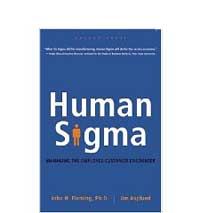HUMAN SIGMA: FIVE NEW RULES FOR MANAGEMENT
 Salah satu konsep manajemen SDM yang menyita perhatian saya akhir-akhir ini adalah Human Sigma. Bukunya sendiri baru masuk ke Indonesia, walaupun konsep ini sudah agak lama terdengar dan dipublikasikan di berbagai tulisan di internet.
Salah satu konsep manajemen SDM yang menyita perhatian saya akhir-akhir ini adalah Human Sigma. Bukunya sendiri baru masuk ke Indonesia, walaupun konsep ini sudah agak lama terdengar dan dipublikasikan di berbagai tulisan di internet.
Setidaknya ada beberapa tulisan tentang Human Sigma ini, yaitu di Gallup Management Journal,(juga di sini), blog Frank Capek, PharmaPulse, review oleh Carrie Cavanaugh, cavehendricks.com, kolom Elbo di Manila Times, serta BusinessWeek. Juga ada video pidato Dr. John Fleming tentang Human Sigma.
Human Sigma adalah konsep yang merupakan implementasi six sigma pada manajemen SDM atau human capital.
The Human Sigma approach combines a proven method for assessing the health of the employee-customer encounter with a disciplined process for improving it. It is based on five new rules to bring excellence to the way employees engage and interact with customers. Companies that follow these principles are outpacing their competition by 26% in gross margin and 85% in sales growth. (BusinessWeek).
Intinya, ada 5 prinsip manajemen yang bisa dipergunakan untuk menciptakan hubungan yang sinergis yang produktif antara karyawan perusahaan dengan pelanggan. Keduanya berada dalam suatu human system, sehingga perlu suatu pendekatan yang khusus untuk memanajemeninya. Lima prinsip ini saya kutip dari Gallup Management Journal.
Rule 1: You can’t measure and manage the employee and customer experiences as separate entities. Because you must manage these human systems in tandem, you may need to reorganize.
Yup, maka semakin jelaslah bahwa hanya karyawan yang satisfied bisa menciptakan service excellent dan customer satisfaction.
Rule 2: Emotion frames the employee-customer encounter. It’s important not to think like an economist or an engineer when you’re assessing employee-customer interactions. Emotions, it turns out, inform both sides’ judgments and behavior even more powerfully than rational or dispassionate thinking. Because employees and customers are people first and employees or customers second, they are prone to all the volatility and irrationality that is the hallmark of being human.
Setuju, aspek manusiawi tidak bisa dibawa ke dalam logika berpikir ekonomi dan engineering. Ini bukanlah sekedar interaksi yang mekanistik dan melulu dihitung dengan nilai ekonomis.
Rule 3: You must measure and manage the employee-customer encounter at a local level. Though companies can manage many kinds of organizational activities effectively from the top down, the employee-customer encounter is an intensely local phenomenon that can vary considerably from location to location within the same company. Because of the variability in local performance, you must measure and manage it locally.
Setuju, aspek manusia sangat local context, tidak bisa bersifat global. Unsur budaya dan kearifan lokal sangat berpengaruh.
Rule 4: We can quantify and summarize the effectiveness of the employee-customer encounter in a single performance measure – the HumanSigma metric – that is powerfully related to financial performance. Our research has revealed that the two sides of the employee-customer encounter potentiate one another and can be quantified into a single HumanSigma metric. The interactive effects of employee and customer engagement at the local level exponentially drive operational and financial performance and growth.
Nah, ini menarik … ternyata hubungannya bolak-balik … lantas bagaimana memodelkannya? Nah, ini yang masih perlu saya pelajari lebih lanjut …
Rule 5: Improvement in local HumanSigma performance requires deliberate and active intervention through attention to a combination of transactional and transformational intervention activities. Measurement by itself is never enough to improve performance. Creating organizational change is hard work and requires active and disciplined intervention.
Tetapi, siapa yang melakukan intervensi transaksional dan trasnformasional itu? Manajemen perusahaan kah? Atau siapa? serta bagaimana bentuknya? Memang dalam system thinking kita mengenal istilah system intervention. Tetapi dalam kasus ini, seperti apa? Ini yang masih harus saya pelajari lebih lanjut …
Jadi, apa yang baru dalam konsep Human Sigma? Menurut saya, ini adalah suatu bentuk implementasi system thinking dalam manajemen SDM, dengan membuat stakeholders utama, yaitu karyawan dan pelanggan berada di dalam satu sistem, dan dimanajemeni secara local context, serta membutuhkan 2 bentuk system intervention … benar-benar konsep system thinking …
Menarik untuk menyimak komentar Reylito A. H. Elbo di Manila Times :
But if you’ll ask me, I’ll say Human Sigma is a derivative of all applicable buzzwords to include among others: Balanced Scorecard, Customer Franchise Management, Customer Relations, Customer Retention, Customer Satisfaction, Employee Empowerment, Glocalization, Human Networking, Market-Driven Management, Maxi-Marketing, Re-engineering, Six Sigma, Total Quality Management, Zero Defections, not necessarily in that alphabetical order. Whew!
“Are you saying that we should ignore that concept?” No. Really, my point is that there’s a deeper value in Human Sigma than what you can superficially imagine. If you’re familiar with Six Sigma alone, then you’ll probably wonder how a Black Belter could improve employee-customer interaction.
Six Sigma is relatively easy to re-engineer production processes in a factory shop floor. But it becomes difficult when you try to do it through people like in the 6M category (machine, material, method, measurement, milieu and man).
Really, people (employees and customers alike) are the hardest component in both the manufacturing and service industries. Even the most perfect system is only as good as the people who are involved in the process. That’s why we need Human Sigma.
Great book anyway !
Resensi buku ini dan resensi-resensi buku lain bertemakan Management dapat juga diakses secara langsung melalui link berikut ini: HUMAN SIGMA : FIVE NEW RULES FOR MANAGEMENT
Kontributor:
 Riri Satria, S. Kom, MM. Selain mejadi blogger yang produktif, Sarjana dari Fakultas Ilmu Komputer UI dan MM bidang manajemen stratejik & internasional dari Sekolah Tinggi Manajemen PPM ini adalah kandidat Doctor dari Program Pasca Sarjana Manajemen dan Bisnis Institut Pertanian Bogor (MB-IPB).
Riri Satria, S. Kom, MM. Selain mejadi blogger yang produktif, Sarjana dari Fakultas Ilmu Komputer UI dan MM bidang manajemen stratejik & internasional dari Sekolah Tinggi Manajemen PPM ini adalah kandidat Doctor dari Program Pasca Sarjana Manajemen dan Bisnis Institut Pertanian Bogor (MB-IPB).
Selama lebih dari 10 tahun kiprahnya di bidang pendidkan dan konsultansi, dia pernah aktif di sebagai konsultan / Dosen di berbagai institusi di antaranya: KPMG (Klynvelt Peat Marwick Goerdeler), Lembaga Manajemen PPM, Program Magister Manajemen – Sekolah Tinggi Manajemen PPM, PT. Daya Makara UI (Makara UI Consulting). Saat ini beliau Menjadi knowledge entrepreneur dengan memimpin sendiri sebuah Lembaga Konsultansi Manajemen di Jakarta.


kalau saya tertarik dengan buku human sigma milik john fleming’s tsb, dimana kira kira saya dapat membelinya? thanks
This is very attention-grabbing, You are an overly skilled blogger.
I have joined your feed and sit up for seeking more of your magnificent post.
Also, I have shared your website in my social networks
Also visit my website http://www.yourtowntube.com/users/DamienBell
There’s a component behind the tiny bones behind your teeth the place it feels smooth.